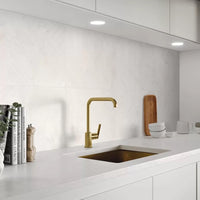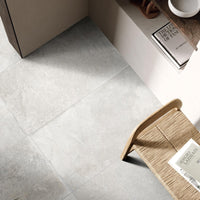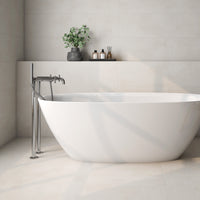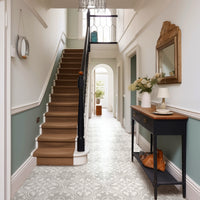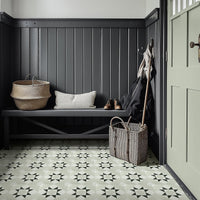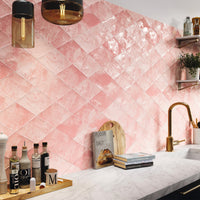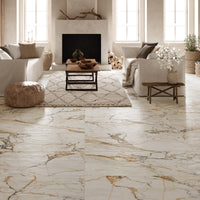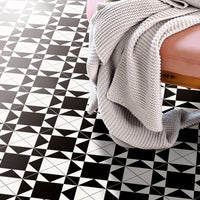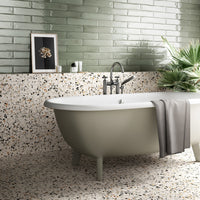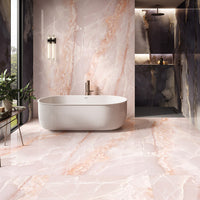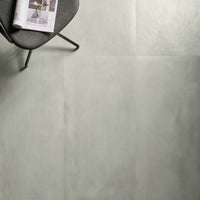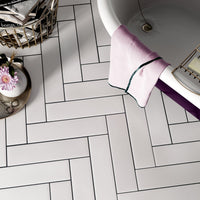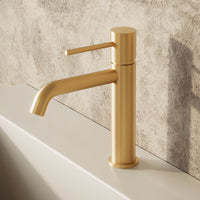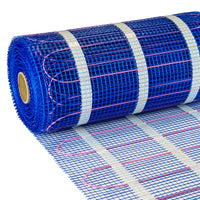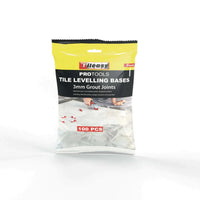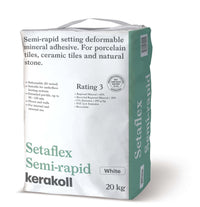Tiles make a great choice when it comes to covering your walls and floors - they’re stylish, durable and in general, pretty easy to maintain. In the past, we’ve tended to think of tiles are purely for kitchens and bathrooms. However these days, we’re copying our continental cousins and using tiles in almost every room. But with so much choice on offer, it can sometimes be daunting knowing which tile is right for you. After all, tiles come in different shapes, sizes and materials and they’re not born equal. We’ll explain the different types of tile and what they have to offer.
1. Ceramic
When you think of tiles, it’s pretty likely that a ceramic tile springs to mind. And with good reason - they’re all around us! You’ll find examples almost anywhere you go; from antique Victorian tiles in your favourite pub, to famous metro tiles on the London Underground and the crackled wall tiles on your kitchen splashback. Ceramic tiles have been manufactured for thousands of years and essentially, the process remains the same. They have a red or white clay biscuit, with decorative glaze applied to the surface and are baked in a kiln at high temperatures to fuse the glaze to the body. In general, ceramic tiles are pretty durable and easy to clean. This makes them a great choice for splash backs and bathrooms walls where there’s likely to be splashes of soaps, shampoos and sauces. Generally, they’re smaller than other types of tile which makes them an ideal choice for a little DIY job. It’s a common misconception that you can’t use ceramic tiles on floors. Balderdash! Although porcelain tiles are becoming a more common sight these days, ceramic tiles still make a great choice for floors at home. While it’s true they’re not as hard-wearing, they come in a range of funky shapes and gorgeous styles that are at the cutting edge of design - take a look at our Seville Persian Blue or Heritage Star designs and see for yourself. Great for - Walls, splashbacks and floors at home
2. Porcelain
There’s a bit of confusion when it comes to what a porcelain tile is so lets start by clearing things up. Technically speaking, a porcelain tile has a water absorption rate of 0.5% so effectively, they’re nearly waterproof. They’re produced using finer clays than ceramic tiles and they’re fired at higher temperatures which makes them incredibly dense and hard. These properties mean that porcelain tiles can be used on almost any wall or floor at home as well as busy commercial floors. Porcelain tiles tend to fit into two categories; glazed and unglazed porcelain tiles.
Glazed Porcelain Tiles
In recent years, glazed porcelain tiles have exploded in popularity and they’re possibly the most popular type of tile worldwide. Similar to ceramic tiles, they consist of a porcelain body with a layer of glaze pattern applied to the surface. Thanks to recent advances in technology, it’s now possible to ‘digitally print’ almost anything onto the surface of a tile - think of your office printer, only on an industrial scale. This means it’s possible to faithfully reproduce wood, marbles and natural stones onto a tile, meaning you get all the character of the natural material married to the many benefits of porcelain. From slate-effect designs to wood-effect planks, we’ve got an incredible range of glazed porcelain tiles that have to be seen to be believed. As these are resistant to water, stains and wear and tear, they’re perfect for use anywhere in your home. Great for - Use throughout the home to combine form with function
Unglazed Porcelain Tiles
Unglazed porcelain tiles don’t contain a layer of glaze - hence the name. Instead, the entire tile is composed of natural clays so that the colour runs all the way through the tile. You might sometimes hear the phrase “full-bodied tile” - that’s another term.
By their very nature, unglazed porcelain tiles are incredibly strong and resistant to abrasion. This makes them perfect for very high traffic areas such as restaurants, bars and busy retail stores, where even a glazed porcelain tile might show signs of wear. Unglazed porcelain tiles can be polished to a mirror-like finish, as you’ll see with our Super White and Polished Porcelain Light Grey tiles. Great for - Busy floors and sleek spaces
3. Mosaics
Who isn’t familiar with beautiful mosaics? First laid by the Ancient Greeks and Romans, mosaic tiles are still incredibly popular today and few other coverings can match their intricate appeal. As you probably know, mosaics consist of small pieces of tile arranged on a sheet. When laid and grouted, this gives the impression of thousands of tiny tiles - or tesserae, to give their formal name. Mosaics can be made from any number of materials such as porcelain, glass, marble, stone, ceramic and even pebbles and come in a variety of shapes. Mosaics are a great way to add detail to your room, so you’ll often find them laid in ‘bands’ or as a feature wall. Because of their small size, you’ll have lots of grout joints - this means mosaics are a great idea for adding extra grip where needed. For example, many people use mosaics in wet room showers or patios - proof that you don’t need to sacrifice form for function! Great for - Introducing detail on feature walls and splashbacks
4. Encaustic Tiles
Here in the UK, we’re blessed with countless fine examples of encaustic tiles thanks to our Victorian forefathers. They took what had been a small-scale medieval production method and turned it into a mass-market machine so and you may be lucky enough to have original tiles at home. Encaustic tiles are made using coloured clays which run through the whole body and up to six different colours could be used to form a pattern in the tile. Our Victorian range of floor tiles are still produced using this time-honoured method. Why not combine Victorian Black and Victorian White together for a classic checkerboard look that’ll never date? As well of being masters of monochrome, the Victorian also had a penchant for patterned tiles. Although it’s still possible to source hand-made decorative encaustic tiles, we have a range of encaustic-effect tiles. This will give your room the charm and character of the originals, but as they’re made from modern ceramic and porcelain they’re a lot easier to care for. And they won’t break the bank either! Our current favourite is Abbey Decor. Great for - Adding a dose of heritage style to hallways and floors
5. Cement Tiles
It’s pretty easy to get cement and encaustic tiles mixed up (it’s even happened to us) but while they might look similar, they’re manufactured in different ways. Whereas encaustic tiles are formed using clay, cement tiles have - you guessed it - a body of cement. They’re also pressed then left to cure, rather than being fired in a kiln. Cement tiles were extremely popular at the turn of the twentieth century but they’re back in fashion again. Or rather, cement-effect tiles are back in fashion. These faithfully mimic the warm, colourful patterns and slight handmade imperfections of the originals, but as they’re made from ceramic and porcelain are much more versatile. Look to patterns such as Heritage Star if you want to have a worn patina; Casablanca Mix will give your room the patchwork style that cement tiles are famed for. Great for - Adding character to smaller spaces
6. Natural Stone Tiles
Natural stone is a bit of a catch all phrase for all the different types of quarried stone, such as marble, slate, travertine and quartz. These have been the building blocks of civilisation for thousands of years and display many desirable qualities. For example, Carrara marble is renowned for it’s timeless beauty, granite for it’s hardness and slate for it’s durability. However, whilst all natural stone are undeniably beautiful, they are extremely expensive, require regular sealing and are more difficult to lay than ceramic and porcelain tiles. Thanks to advances in digital printing, there are now man-made tiles that accurately replicate the richness of natural stone without the extra hassle and cost. For example, whist real Calacatta marble will set you back hundreds of pounds per square metres, our Timeless White marble style tiles are just a small fraction of the cost. And side by side, we think a geologist would struggle to tell the difference! Great for - Luxury and the wow-effect
Terracotta Tiles
To us, terracotta conjures up images of sunny Mediterranean holidays but did you know that the name is derived from the Latin for ‘baked earth’? Probably the most humble form of tile available, terracotta is produced by shaping special clay into a mould and firing this in a kiln, although some artisan producers leave their tiles out to dry naturally in the sun! As you’re probably aware, the warm look of terracotta is perfect for recreating the country kitchen or rustic style at home. However, natural terracotta tiles are extremely porous and liable to stain or crack. These days, it makes much more sense to invest in mad-made terracotta effect tiles which will give you the same weathered look but are far easier to maintain. Great for - A little slice of Mediterranean chic at home
